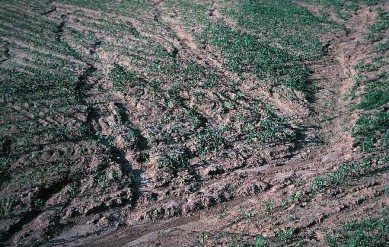5.6. Soil Erosion
It is the removal of soil at a greater rate than its replacement by natural agencies. Soil forming and erosional processes go on simultaneously. When the balance between these two different processes is disturbed by natural or human factors, result into net removal of soil. Some soil erosion occurs without the intervention of human activities but the latter often accelerates the natural processes, e.g. vegetation clearance, over-grazing, some land-drainage schemes. Problem of soil erosion increases with pressure of increasing population on the land. Natural vegetation is cleared for agricultural, pastoral and construction activities.
Topography, rainfall, wind, lack of vegetation cover, land use practices etc. are the causes of soil erosion. The rugged topography and steep slopes affect soil erosion rate through its morphological characteristics. Two of these, namely gradient and slope length, are essential components in quantitative relationships for estimating soil loss. Erosion increases dramatically because the increased angle facilitates water flow and soil movement.
Two main elements of climate – wind and rainfall – are powerful agents of soil erosion. Erosive processes are set in motion by the energy transmitted from either rainfall or wind or a combination of these forces. Wind erosion is significant in arid and semi-arid regions. Regions with heavy rainfall have dominance of water in erosional processes. Removal may be in the form of splash erosion, Sheet wash, Rill erosion, gullying erosion (figure 25). Splash erosion is the first stage in soil erosion and it occurs when raindrop hit bare soil. Sheet erosion, takes place on level of lands after a heavy shower, removes finer and fertile top soil. Gullies cut the
agricultural lands into small fragments and make them unfit for cultivation. Chambal region of central India is infamous for its ravines (large number of deep gullies).

